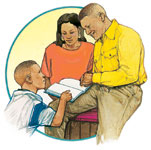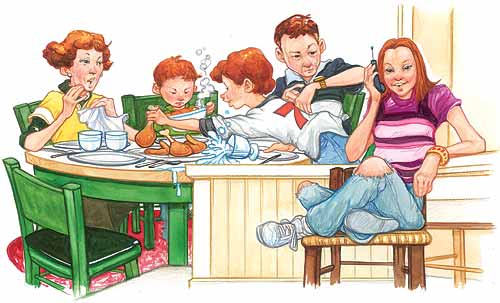
Manners Do Matter
By Richard M. Romney
Illustration by Joel Snyder
Teaching children to be polite can be a challenge in a world where common courtesy is less and less common, but you can be successful by working at it a little at a time.
 |
Can you imagine your children in any of the following situations? If you can, you're not alone.
- Three young brothers think the funniest thing in the world is a colossal burping contest at the dinner table.
- A boy wants to borrow his younger brother's new basketball. The younger boy isn't home, so the brother just takes it.
- Several teens stop by a friend's home; the friend is temporarily busy. Without asking permission, the visitors go into the kitchen; search cupboards, refrigerator, and freezer for snacks; then help themselves to what they find.
These are actual experiences shared by real parents. If you're like me, you winced a bit as you read them, because you could imagine your own children doing similar things. The truth is, we live in a time when manners—the simple rules people follow to help everyone feel at ease—are not stressed as they used to be. The Better Homes and Gardens magazine Web site, www.bhg.com, in the article "Teaching Children Manners," reports that today's child is much less mannerly than the typical child of a generation ago, and that "unfortunately, unless children learn respect for others, beginning with adults, they can never learn to respect themselves."
Educator and psychologist Alex J. Packer, Ph.D., author of the "How Rude!" series (Free Spirit Publishing, Minneapolis, Minn., 2004, www.freespirit.com) of manners guides for teens, agrees. He cites statistics from the Public Agenda research group showing eight of 10 people agree that lack of courtesy is a serious national problem. Dr. Packer says the solution is for parents to teach manners in the home and that it's never too early to start.
"Manners education begins at the cradle," Dr. Packer said in a recent interview. "Parents responding to a child's needs are demonstrating good manners (as well as love). Teaching a child to share, to not hit or bite, to keep certain comments or behaviors private—this is all manners instruction."
He also stated that, at the most basic level, good manners are the first line of defense against daily irritations, conflict, and even violence.
"So [children] with good manners possess skills that increase the likelihood that they will stay safe in an increasingly uncivil world," Dr. Packer said. "And on a more upbeat level, good manners are impressive, attractive, and increasingly hard to find....Good manners bring their own rewards—respect, praise, gratitude, gifts, trust, and freedom."
Parents and significant adults should focus on noticing and reinforcing good manners, rather than pointing out bad manners, Dr. Packer advised. Fortunately, there are many opportunities, day by day, to do this, helping children to understand in the process that, when they use good manners, everyone wins.
Here are some tips from Dr. Packer to establish good manners in the home:
Model, model, model.
"Kids learn from watching the behavior of others, and if that behavior is rude, mean, unfair, arbitrary and/or selfish, that's what they'll learn," Dr. Packer said. "Given the rampant rudeness in the world today, it's no wonder many teens are discourteous and disrespectful. Therefore, parents need to be shining examples of the behavior they hope to see in their children."
"First of all, as parents we have to remember to be polite to each other," said Angie Haynes of Pflugerville, Tex. "Children mirror what they see from others, especially parents." She and her husband, Dan, are teaching their 3-year-old daughter, Jaeden, to use three important words. "We say 'please' and 'thank you,' and remind her that she should do the same," said Angie. "If she forgets, we encourage her with a question like, 'Is that how we ask for something nicely?' We feel that if she's old enough to talk, she's old enough to learn to say 'please.'"
Recognize and reward good manners.
Rather than punish bad manners, respond to a child's rudeness with consequences that draw connections for the child between the behavior and the parent's response. For example, if a child took and broke a sibling's possession, he has to replace it.
If a child is impolite, explain to him or her why the behavior is rude.
In other words, Dr. Packer said, "[the behavior] hurt somebody's feelings; it was intrusive; it overstepped a boundary; it created a mess for someone else."
Be explicit about the connection between good behavior and privileges the child enjoys.
"Your child's good manners and responsible behavior are why you let him sleep over at a friend's house; invite schoolmates over to play; ride the bus by himself," Dr. Packer said. "There's nothing wrong with appealing to a child's self-interest as motivation for adopting good manners."
Don't place your child in situations that require self-control beyond his development.
An example would be taking most young children to an upscale restaurant or one that is not kid-friendly. The dinner table at home, though, presents many opportunities to teach kids the table manners they will soon need to depend on in public.
Dave and Cynthia Benson of Mesa, Ariz., are the parents of children ages 5, 7, 11, 13, and 14, four of them boys. "As soon as we feel comfortable that they can hold a nice dish without breaking it, we let them help to serve refreshments to guests," said Cynthia. "Kids love to bring out bowls of ice cream and give everyone napkins, for example. And sometimes for Sunday dinner at home, even though it's just with the family, we make it formal and let them help set the table, so we can remind them where the spoon and fork should go."
Be willing to acknowledge that "proper" etiquette can be silly or arbitrary sometimes.
Specifically, Dr. Packer distinguishes between "manners" and "etiquette," emphasizing that while etiquette changes over time and from culture to culture, "manners are the overarching customs and traditions that govern how people treat one another and behave in social situations."
"[Manners] are based on virtues such as kindness, consideration, and gratitude, being sensitive to and respectful of, the needs, desires, rights, feelings, and property of others," Dr. Packer said. "Such virtues are timeless; they are always important....'Etiquette' can be thought of as the specific rules and behaviors that give expression to manners."
Children and teenagers often ask Dr. Packer why manners are so important. "Isn't it what's inside a person that counts?" they argue.
"I tell them that, yes, what's 'inside' is ultimately most important," the psychologist said, "but nobody's going to stick around long enough to get to know the 'real you' if being in your presence grosses them out."
Anna Lisa DePaul, a Salt Lake City-based writer who, with husband, Steve, is a parent to eight children, puts it this way: "Helping children learn manners takes patience and determination. You teach good manners because you know that good manners make a person nice to know, and you want your children to be nice to know."
Freelance writer Richard M. Romney also wrote the September 2006 Family Talk column, "Honestly, NowŠ."
Five Well-Mannered BooksYou'd like to teach your children about manners, but you don't know where to start? Here are some books that might be of help to you: Last Straw Strategies: Manners, by Michelle Kennedy, is particularly helpful for children ages 2-6. It contains more than 100 one-page activities that are easy for parents and children to do together. (Ivy Press Limited, Barron's Educational Series Inc., 2004) Taking "No" for an Answer and Other Skills Children Need, by Laurie Simons, M.A., includes 50 games to teach family skills, many of them related to manners. (Parenting Press Inc., 2000) Nanny 911: Expert Advice for All Your Parenting Emergencies, by Deborah Carroll and Stella Reid, based on the television series, contains some sections on manners and respect, and can be particularly helpful when dealing with crises like whining, tantrums, and inappropriate behavior in restaurants and other public places. (Regan Books, an imprint of HarperCollins, 2005) Life Skills for Kids: Equipping Your Child for the Real World, by Christine M. Field, contains excellent sections about formal and informal dining, telephone etiquette, and biblical accounts of good manners in action. (A Shaw Book, Waterbrook Press, 2000) Laying Down the Law: The 25 Laws of Parenting to Keep Your Kids on Track, Out of Trouble, and (Pretty Much ) Under Control, by Dr. Ruth Peters, devotes a chapter to manners, the content of which is particularly helpful in the teaching of the importance of telephone manners. Perhaps nowhere is the lack of manners as quickly evident as on the telephone. Dr. Peters's advice of "Teach your children that if they are to answer the telephone, it must be done politely" is backed up with plenty of specific, kid-friendly instructions to accomplish this. (Rodale, 2002) —R.M.R. |
March - April 2007 Table of Contents
Copyright © 2007 by the Boy Scouts of America. All rights thereunder reserved; anything appearing in Scouting magazine or on its Web site may not be reprinted either wholly or in part without written permission. Because of freedom given authors, opinions may not reflect official concurrence.